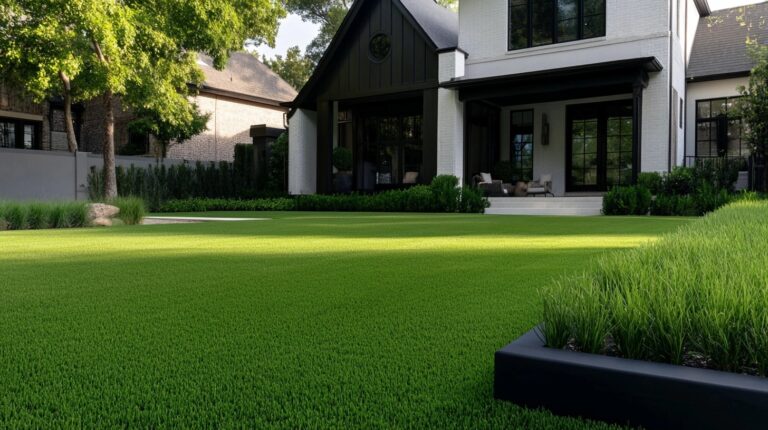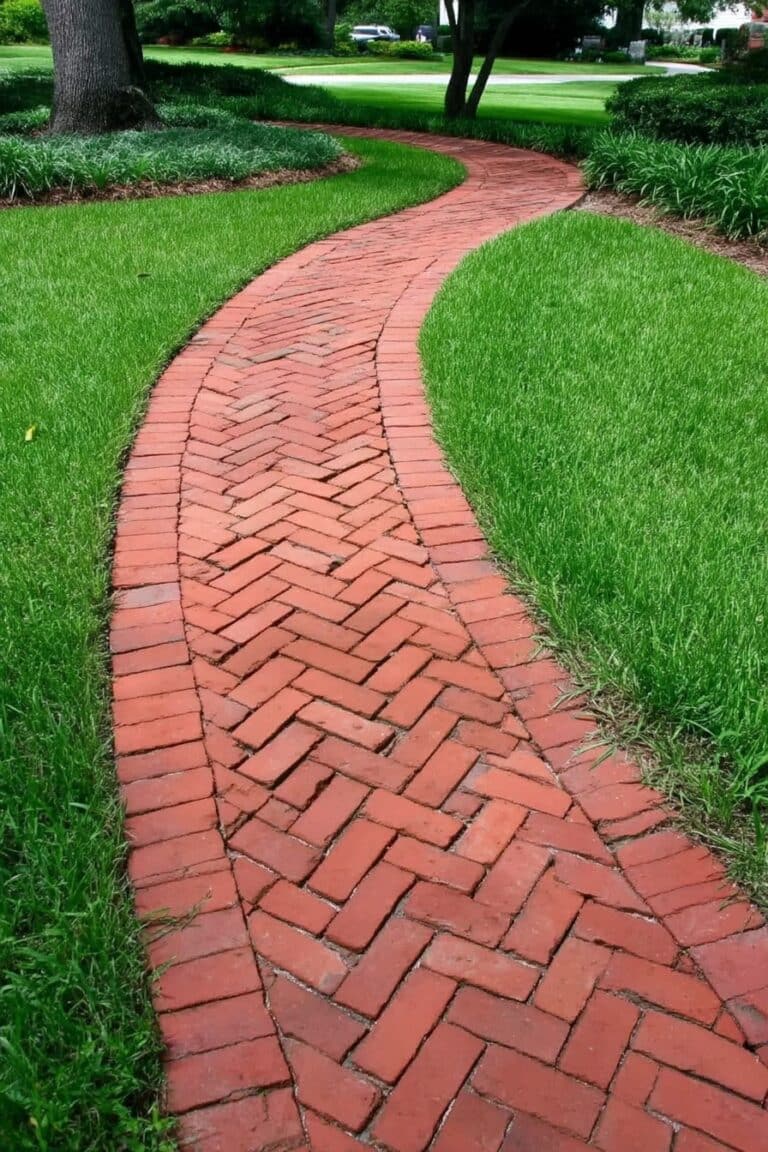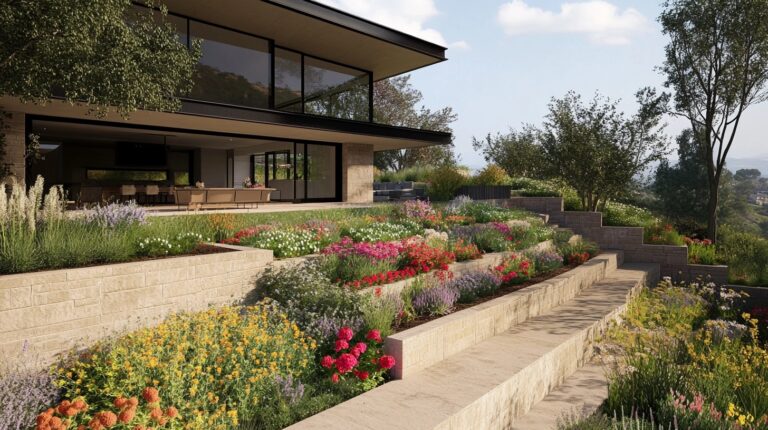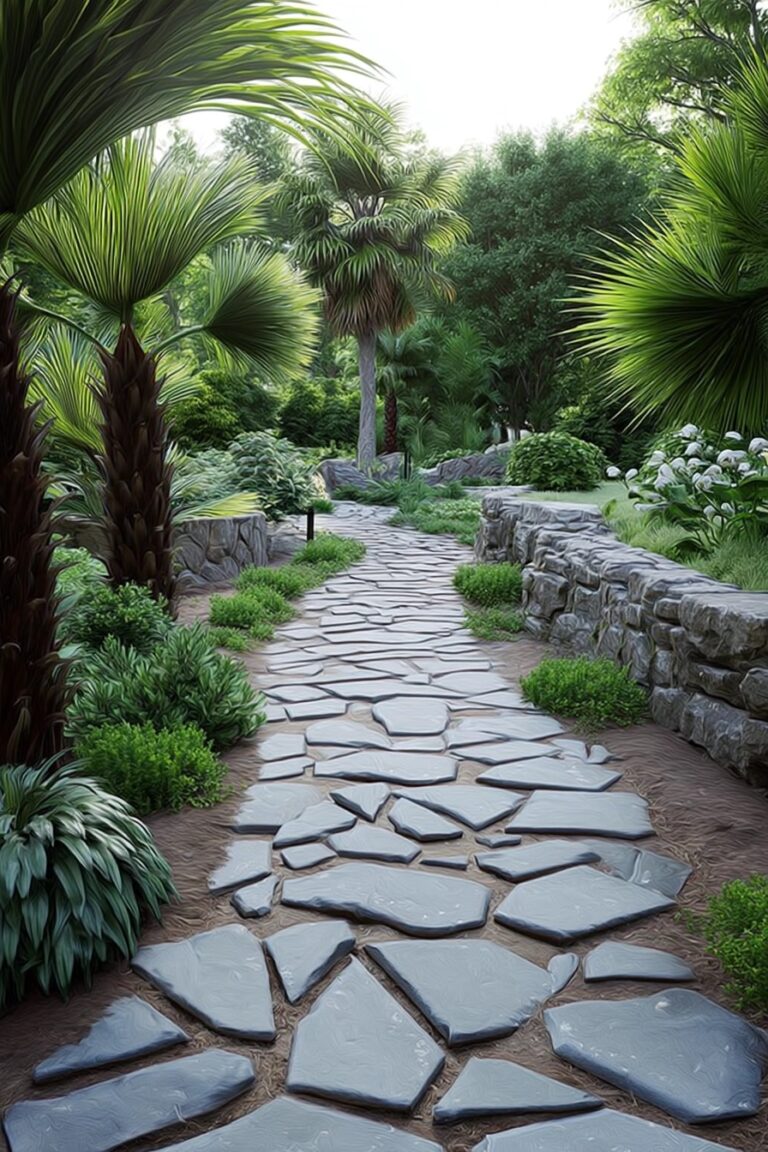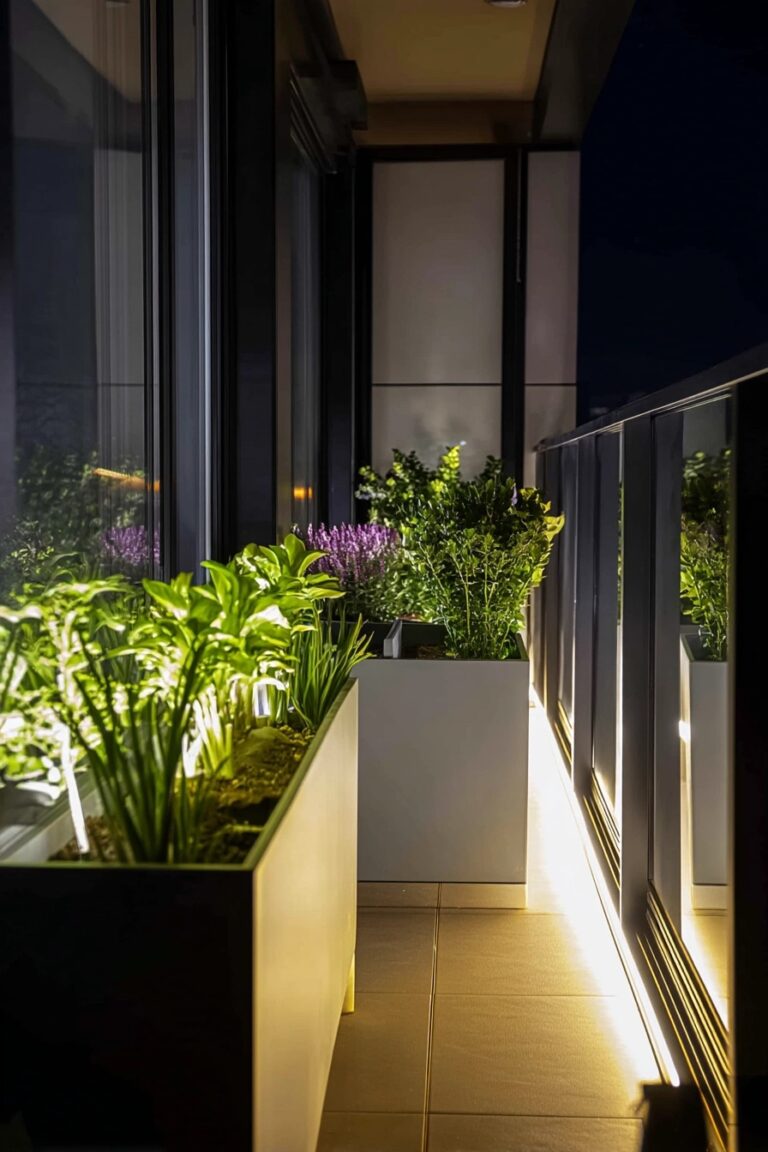It’s incredible how versatile simple stones can be, creating everything from sleek modern looks to charming cottage vibes. Ready to explore some gorgeous gravel front garden ideas and give your curb appeal a serious boost?
21 Elegant Gravel Front Garden Ideas for Instant Curb Appeal & Low Maintenance
1. Modern Mix: Wood Decking Meets River Stones
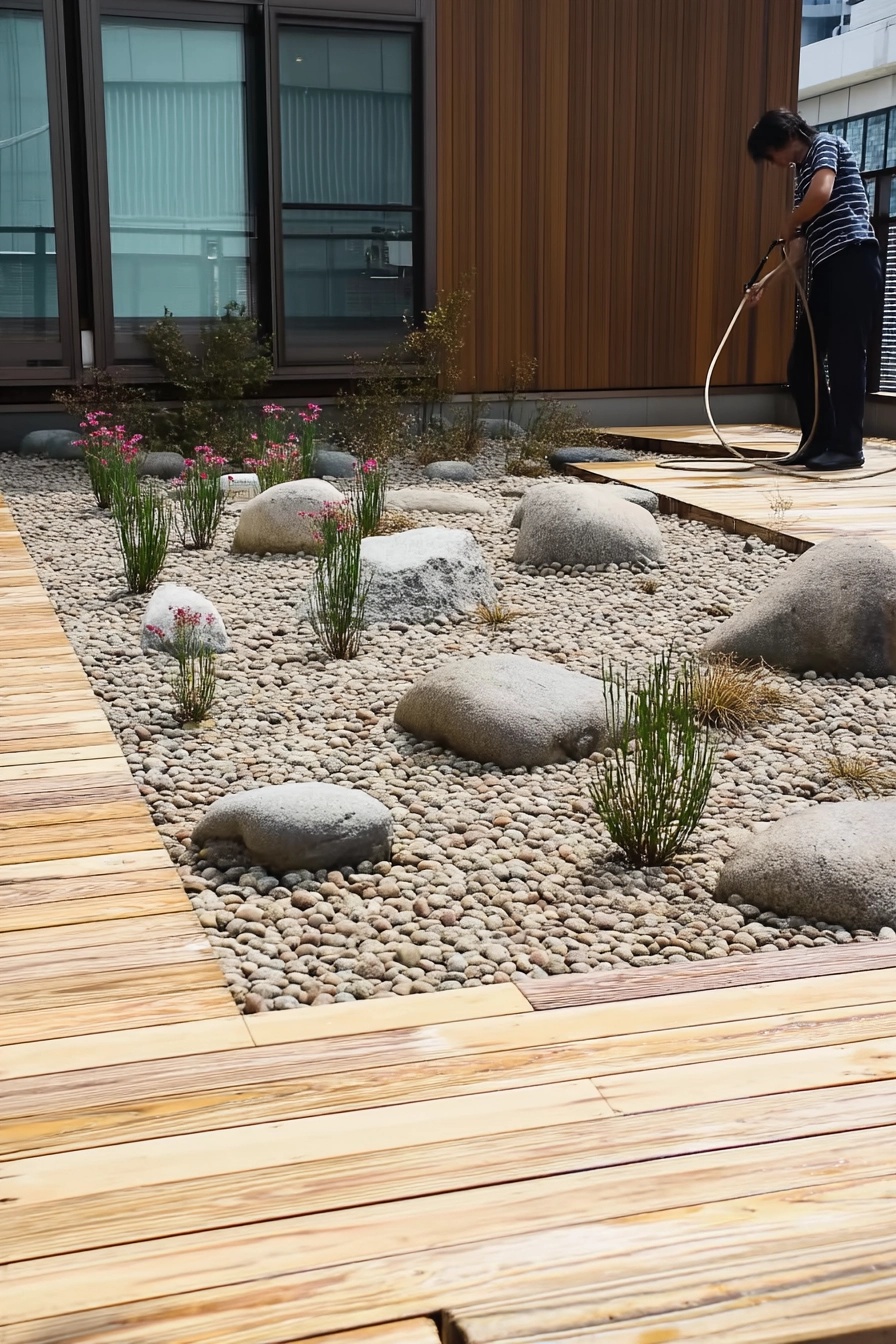
Okay, look how sharp this is! Combining warm wood decking with cool, smooth river stones gives you amazing texture contrast. It feels very modern and clean, almost like a zen garden but a bit more relaxed.
Using larger stones like these means less shifting around than tiny pea gravel. But here’s the deal: you absolutely NEED good landscape fabric underneath. Weeds will find a way, trust me on this. I learned that the hard way in my first Arizona rock garden attempt!
- Pros: Looks super stylish and contemporary.
- Cons: Larger stones can be pricier and heavier to install.
This kind of design is great if you want minimal planting. A few well-placed ornamental grasses or architectural plants are all you need. Just imagine hosing it down on a hot day – easy peasy!
2. Rustic Charm: Flagstone Path with Gravel Infill
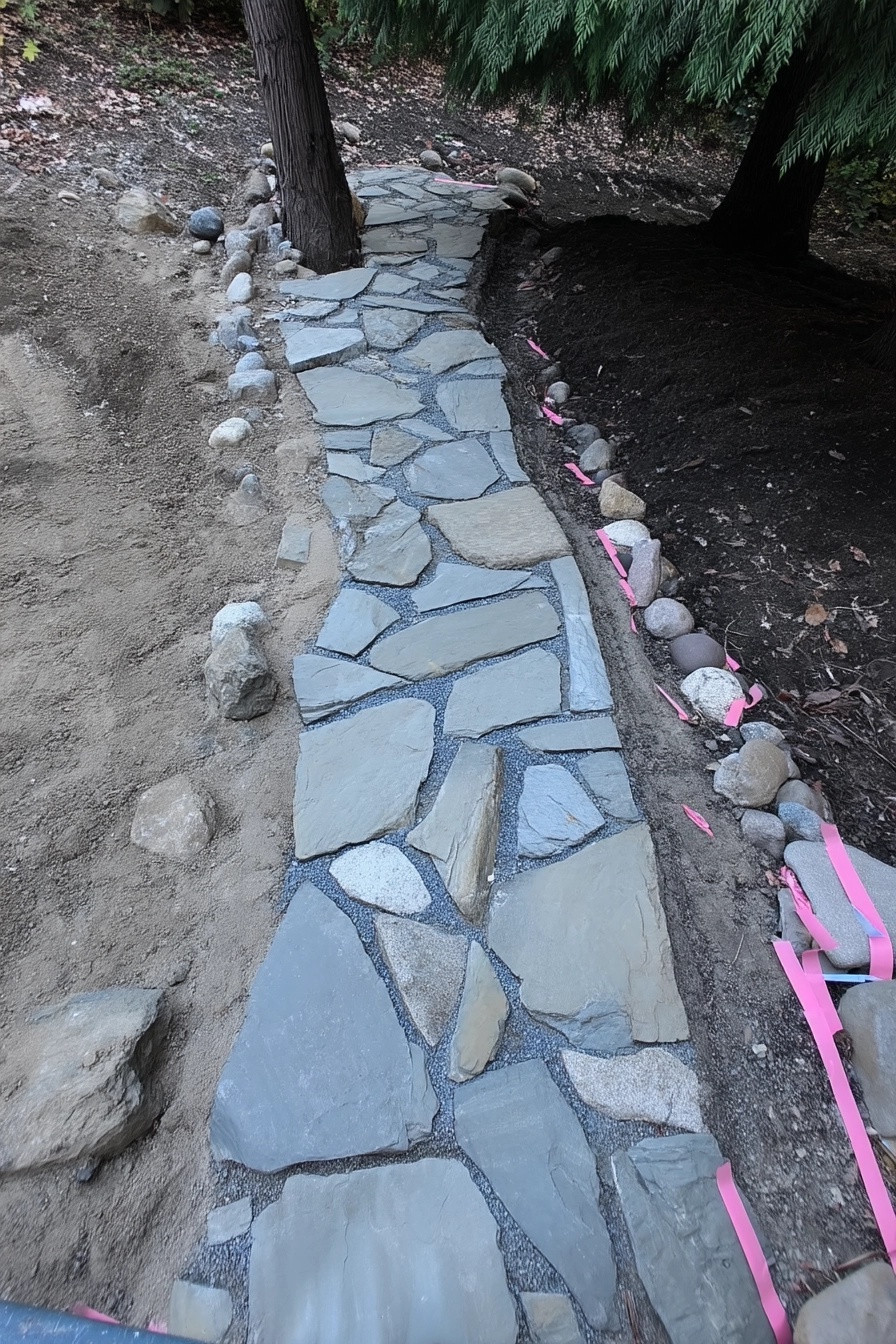
Now this is more down-to-earth. A winding flagstone path feels natural and inviting. See how they used smaller, darker gravel to fill the gaps between the stones? That’s a smart move.
It helps lock the flagstones in place and keeps weeds down (again, fabric underneath is your friend!). This look is perfect for a more naturalistic or woodland-style front garden.
Hot take: Don’t strive for perfection here. Part of the charm is the slightly uneven stones and the way the path curves. Trying to make it ruler-straight ruins the vibe. Let it wander a bit!
Laying flagstone like this is totally doable as a DIY project. Just be prepared for some heavy lifting and leveling. A rubber mallet is your best buddy for settling the stones.
3. Clean Lines: Pavers and Gravel Combo
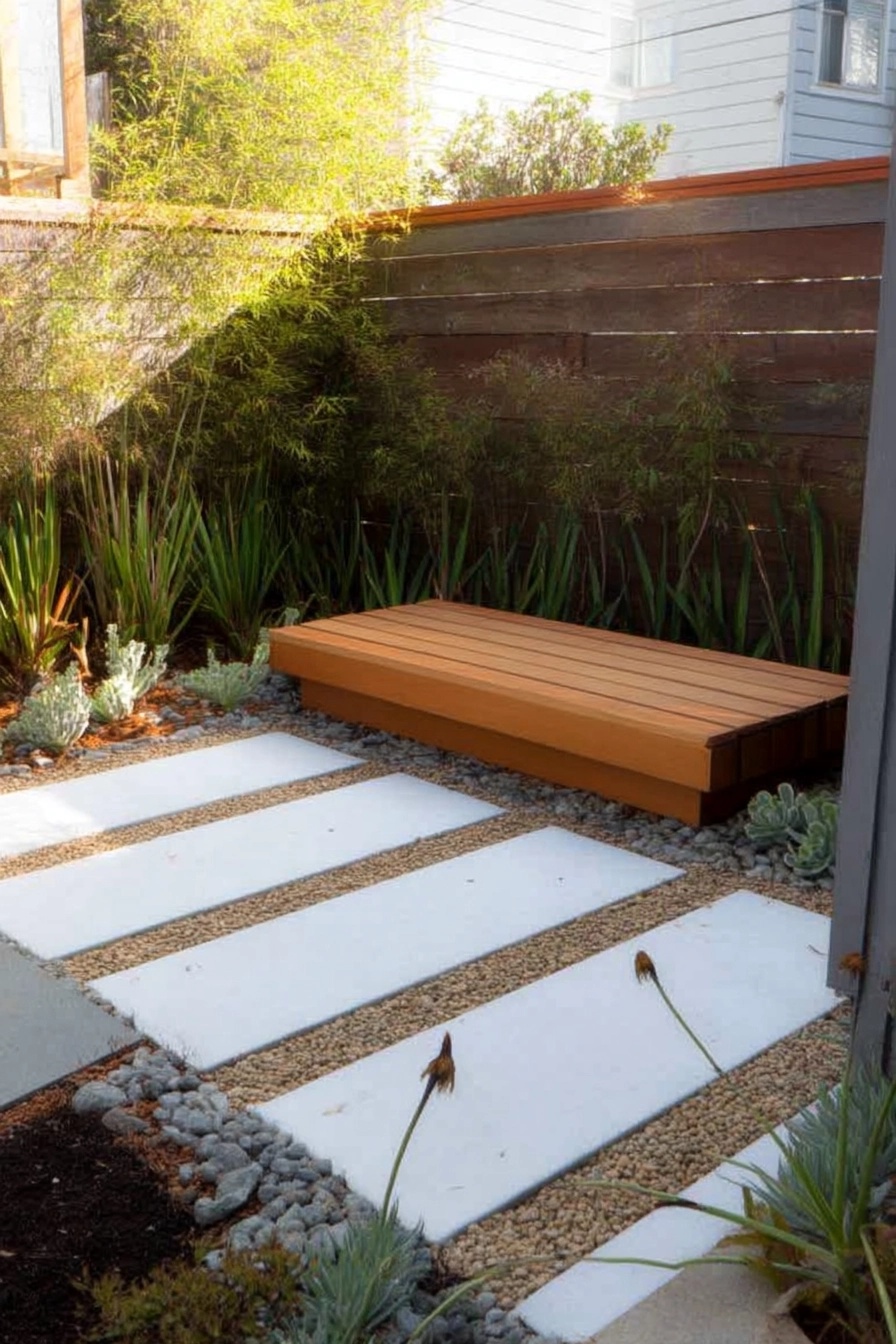
Love this clean, geometric look! Using large concrete pavers with gravel in between is a super popular front garden idea right now, and for good reason. It’s stylish and relatively low maintenance.
The key here is the contrast – smooth pavers against textured gravel. Notice the pea gravel they used? It’s rounded and gives a softer feel than angular crushed stone.
- Tip: Ensure your pavers are set slightly higher than the gravel level. This keeps the gravel contained and makes walking easier.
- Watch out for: Pea gravel can sometimes travel onto the pavers, especially if you have kids or pets running around. A quick sweep fixes it though.
This style works brilliantly with drought-tolerant plants like succulents, as you see here. It feels very California or Southwest modern – reminds me a bit of landscaping trends I saw taking off in Phoenix.
4. High Contrast: Dark Pavers, White Gravel

Wow, talk about contrast! Pairing dark pavers with bright white gravel makes a bold statement. It’s incredibly crisp and really defines the pathway.
White gravel, often marble chips, looks amazing when it’s new. But let’s be real: it shows dirt and algae more easily, especially in damp or shady spots. You’ll need to rake it occasionally and maybe even give it a gentle wash or top-up layer now and then to keep it sparkling.
I personally prefer slightly off-white or light grey gravel for pathways for this reason. Still bright, but a bit more forgiving! But hey, if you love the pure white look and don’t mind a little upkeep, go for it.
5. Structured Style: Gravel Zones & Topiary
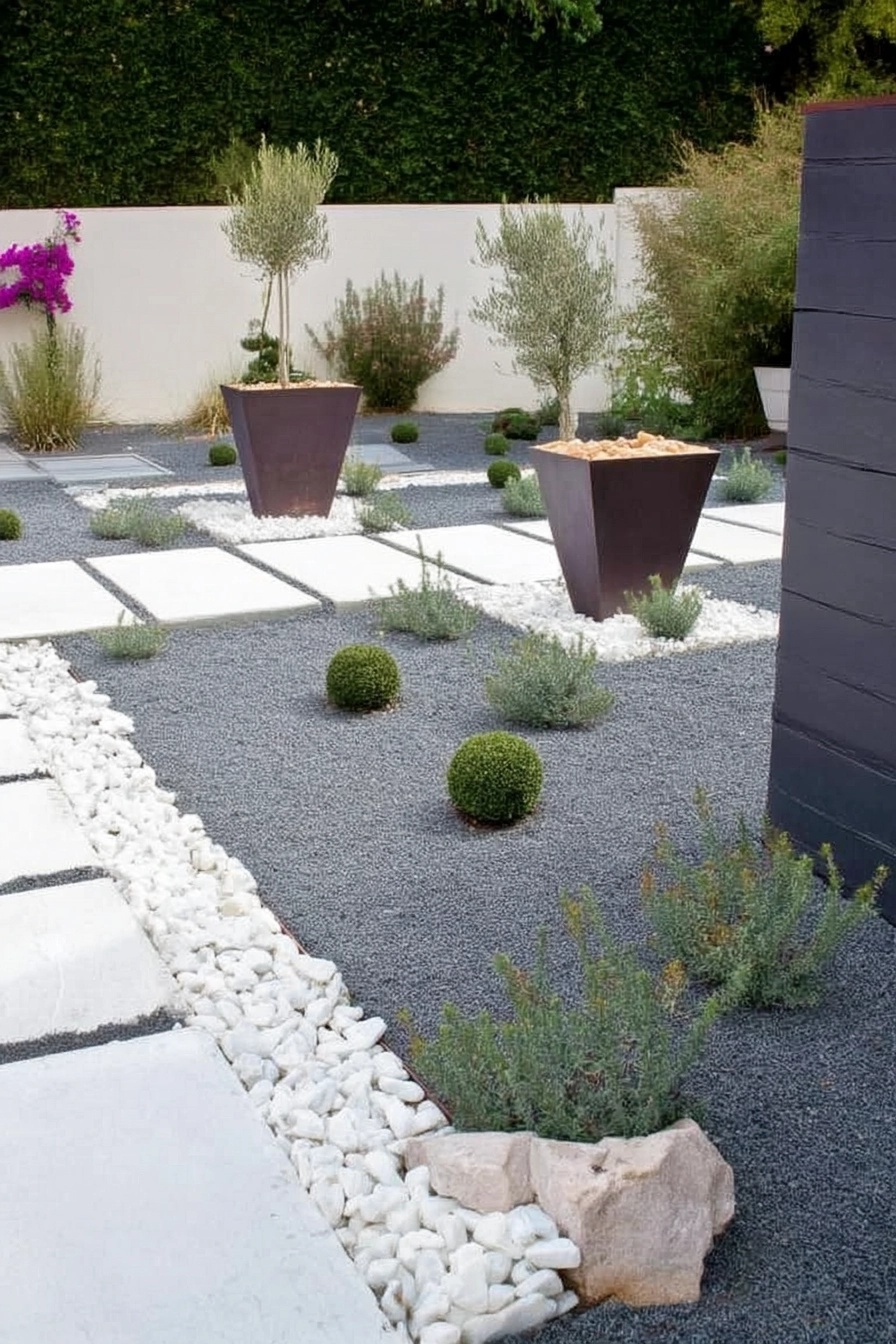
This front garden gravel idea is much more formal. They’ve used different gravels – dark grey for the main beds and white for borders along the pavers – to create distinct zones.
Adding clipped topiary balls and tall planters reinforces that structured, elegant feel. This isn’t a “kick off your shoes and run around” kind of garden; it’s designed to impress from the curb.
Maintaining this look requires precision. You’ll need sharp edges between the gravel types (metal edging works great) and regular pruning for the topiary. It’s a higher-effort style compared to more naturalistic gravel gardens.
Controversial opinion: Sometimes these super formal designs can feel a bit cold or impersonal. I like mixing in a few softer, less structured plants to prevent it looking too rigid, but that’s just me!
6. Color Pop: Bright Gravel Meets Purple Flowers
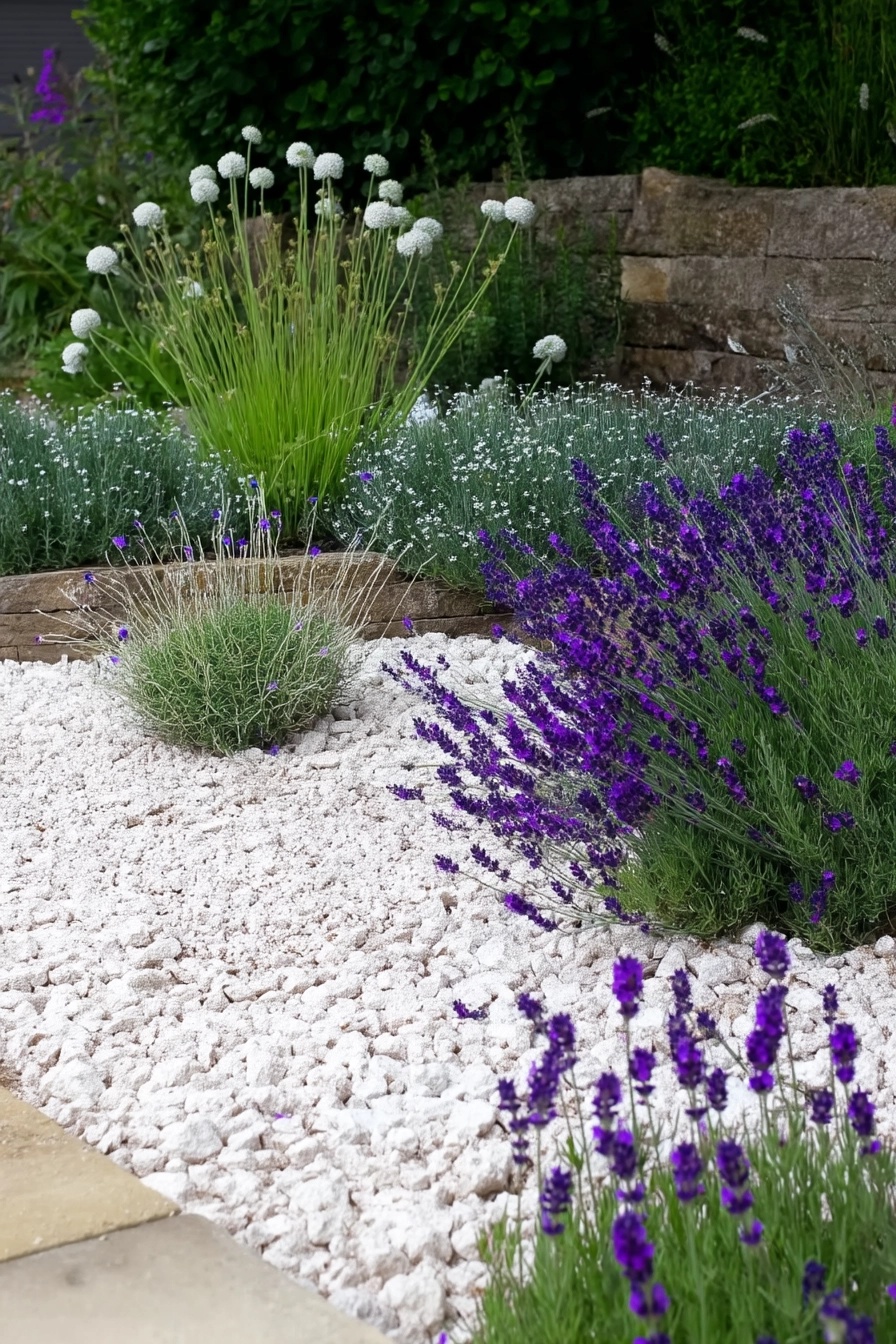
See how amazing vibrant flowers look against bright gravel? This white gravel really makes that purple lavender pop! It’s like a natural spotlight for your plants.
This is a fantastic gravel garden idea for showcasing specific plants. Lavender, Russian Sage, Santolina (Cotton Lavender), and ornamental grasses all look stunning against light-colored gravel.
Remember my warning about white gravel showing dirt? It applies here too, especially under plants where leaves might drop. But the visual payoff is huge! A leaf blower on a low setting can help clear debris without blasting the gravel everywhere.
- Planting Tip: When planting in gravel, clear a space, dig your hole (amending the soil if needed), plant, then pull the gravel back around the base, leaving a small gap around the stem.
7. Desert Dreams: Gravel & Succulent Paradise
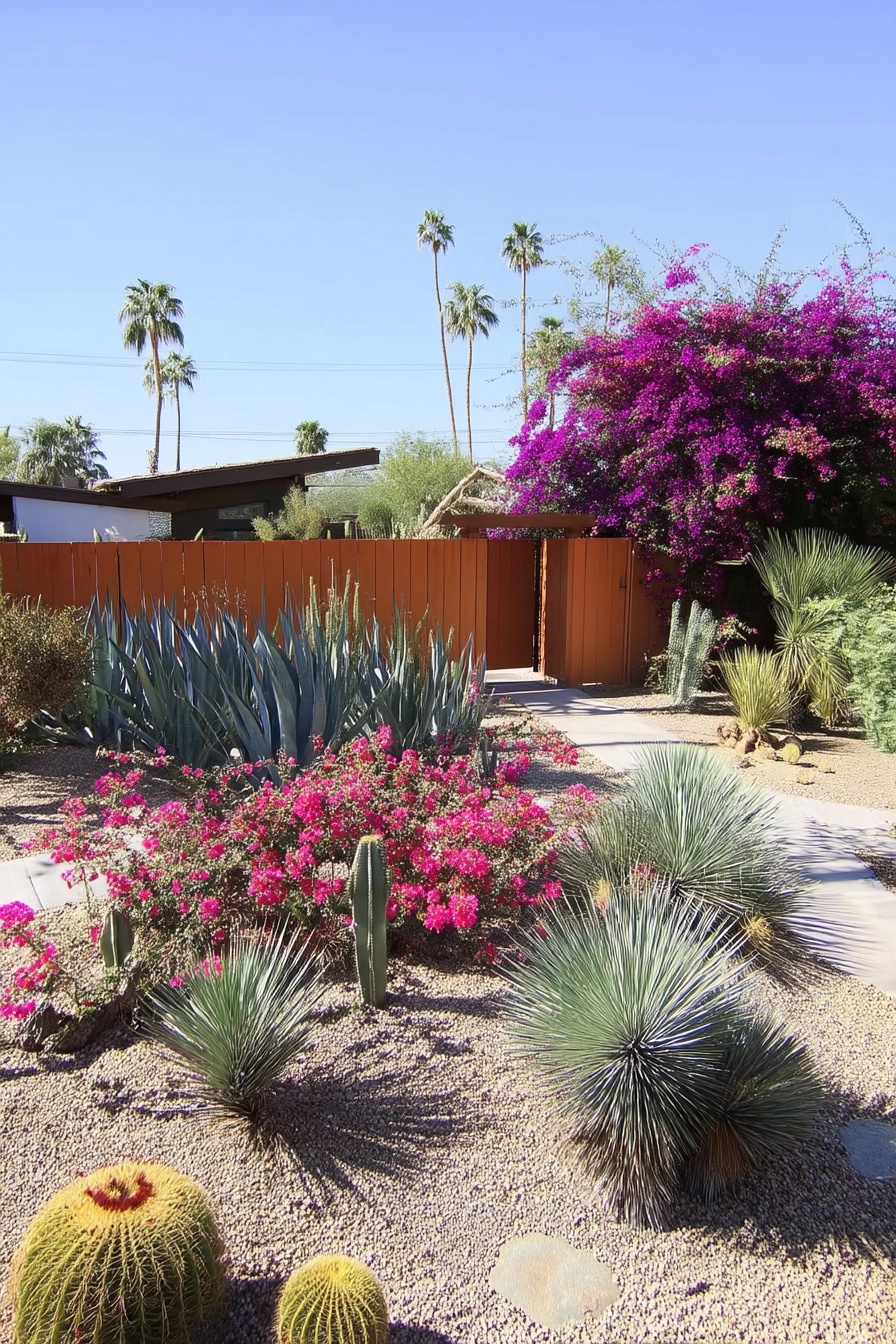
Ah, this takes me back to Arizona! This is a classic gravel front yard approach for dry climates. Using gravel as mulch conserves water beautifully and looks fantastic with cacti, agaves, yuccas, and vibrant bloomers like bougainvillea.
The gravel here looks like decomposed granite or pea gravel in warm, earthy tones, which complements the desert theme perfectly. Notice the mix of plant shapes and sizes – that’s key to making it look lush, not sparse.
Pros of this style:
- Super water-wise (xeriscaping!).
- Very low maintenance once established.
- Thrives in heat and sun.
Cons to consider:
- Gravel retains heat, making the area feel hotter.
- Some critters (scorpions in AZ!) love hiding under rocks. Gotta be aware!
- Needs full sun; won’t work well in shady spots.
8. Courtyard Chic: Gravel Unifies the Space
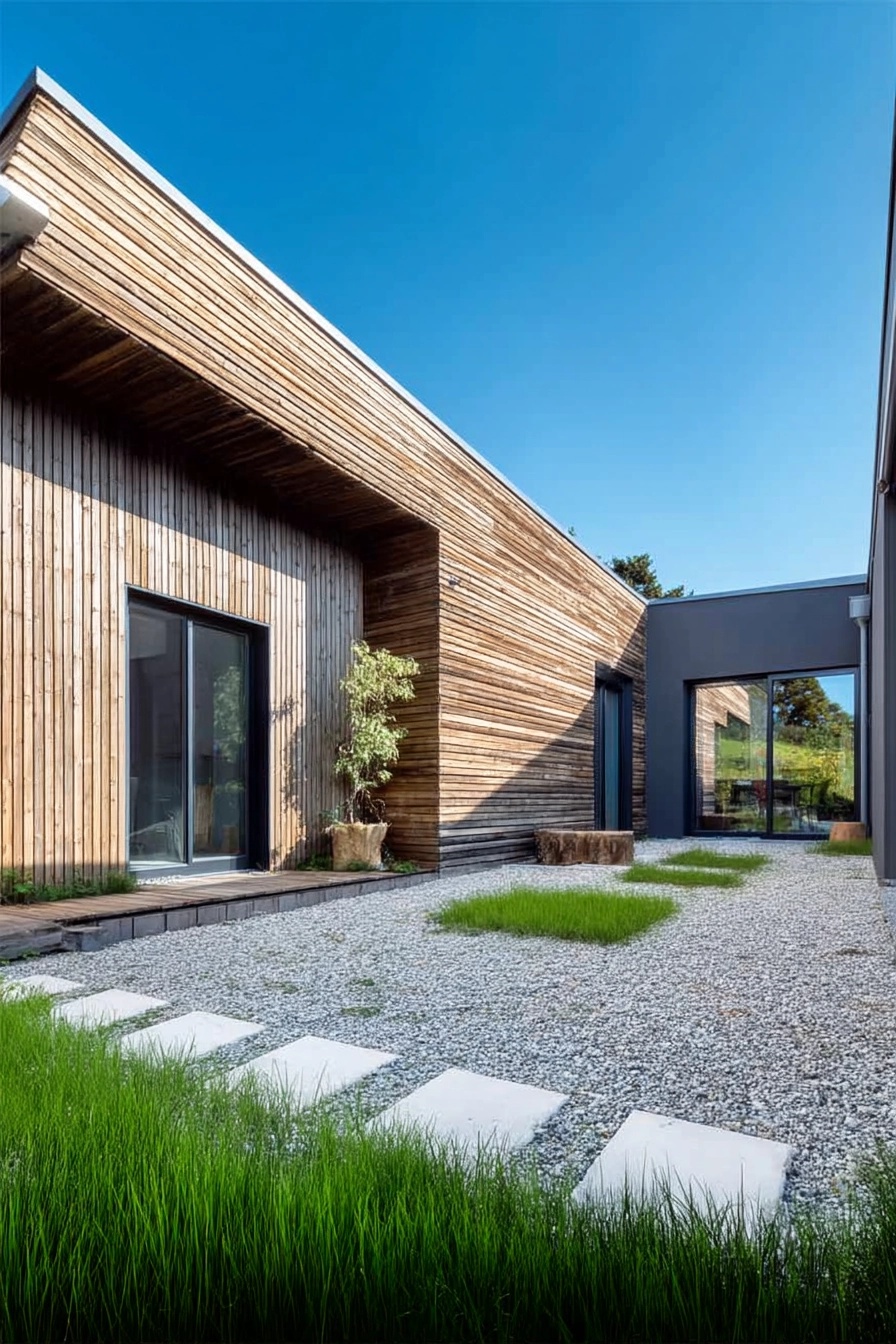
Here, gravel isn’t just a path or a bed, it’s the main floor of this modern courtyard entrance. Using one type of gravel throughout like this really unifies the space and makes it feel larger.
Breaking it up with those simple concrete squares and tiny grass patches adds just enough interest without cluttering the minimalist vibe. It’s practical, too – permeable surface means good drainage.
This is a great gravel front garden idea for smaller urban spaces or side yards. It turns a potentially awkward area into a sleek, usable entry court. Imagine adding a simple bench or a couple of modern planters!
9. Wild & Wonderful: Naturalistic Gravel Planting
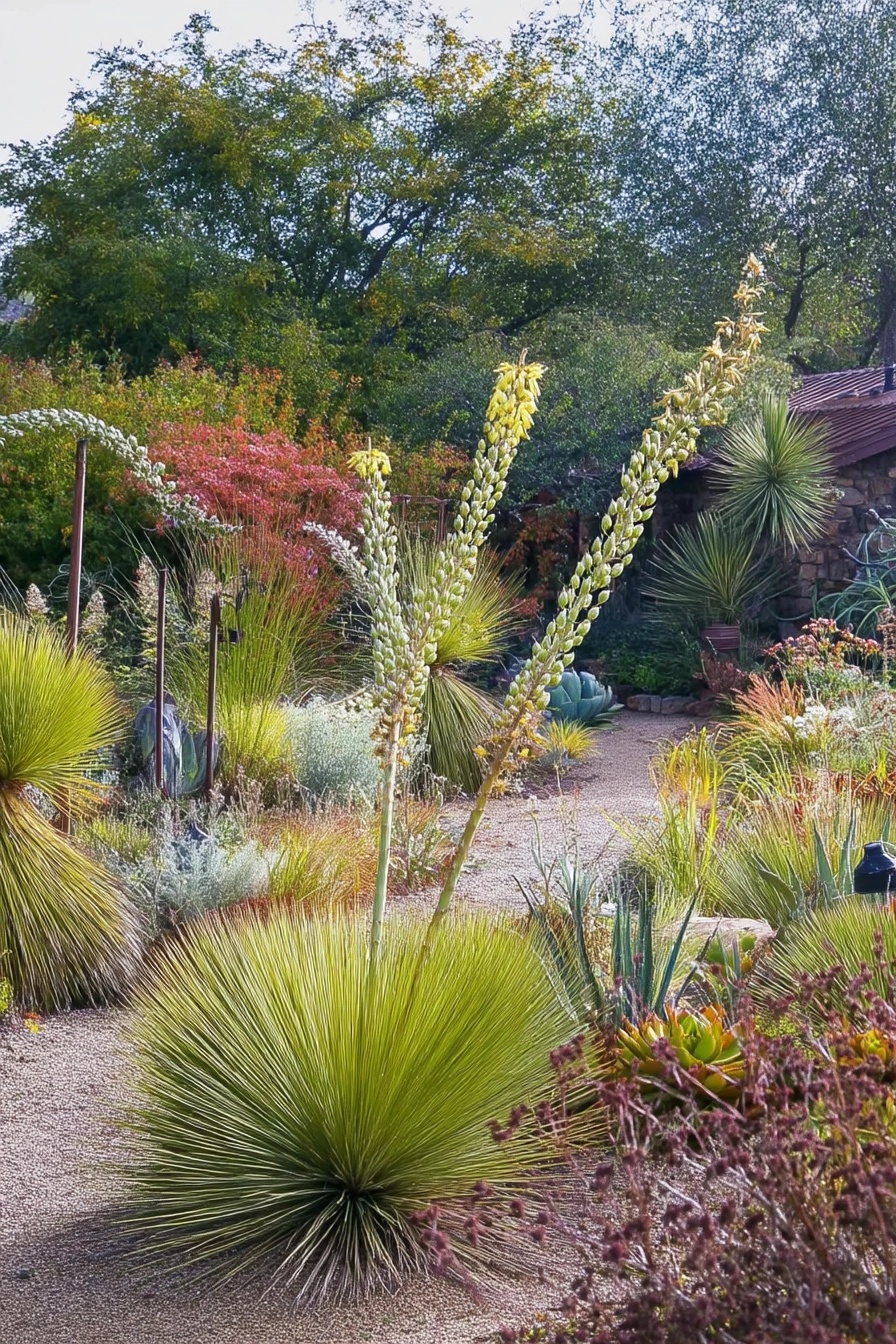
This feels much wilder, doesn’t it? Like a slice of a beautiful, natural landscape. The gravel path just meanders through, letting the plants be the stars.
This style uses plants that look good mingling together – ornamental grasses, yuccas, maybe some sedums or echinaceas. The gravel acts as a unifying mulch that suppresses weeds and keeps moisture in the soil.
It’s designed to look a bit untamed, which I love. Don’t try to space plants out too evenly in this kind of design. Group them in drifts, let some spill over the path edge slightly. It’s about capturing nature’s organized chaos.
This gravel garden idea is perfect if you like a more relaxed, prairie, or Mediterranean feel. It’s also generally lower maintenance than formal beds once the plants get established.
10. Multi-Zone Magic: Gravel Connects the Dots
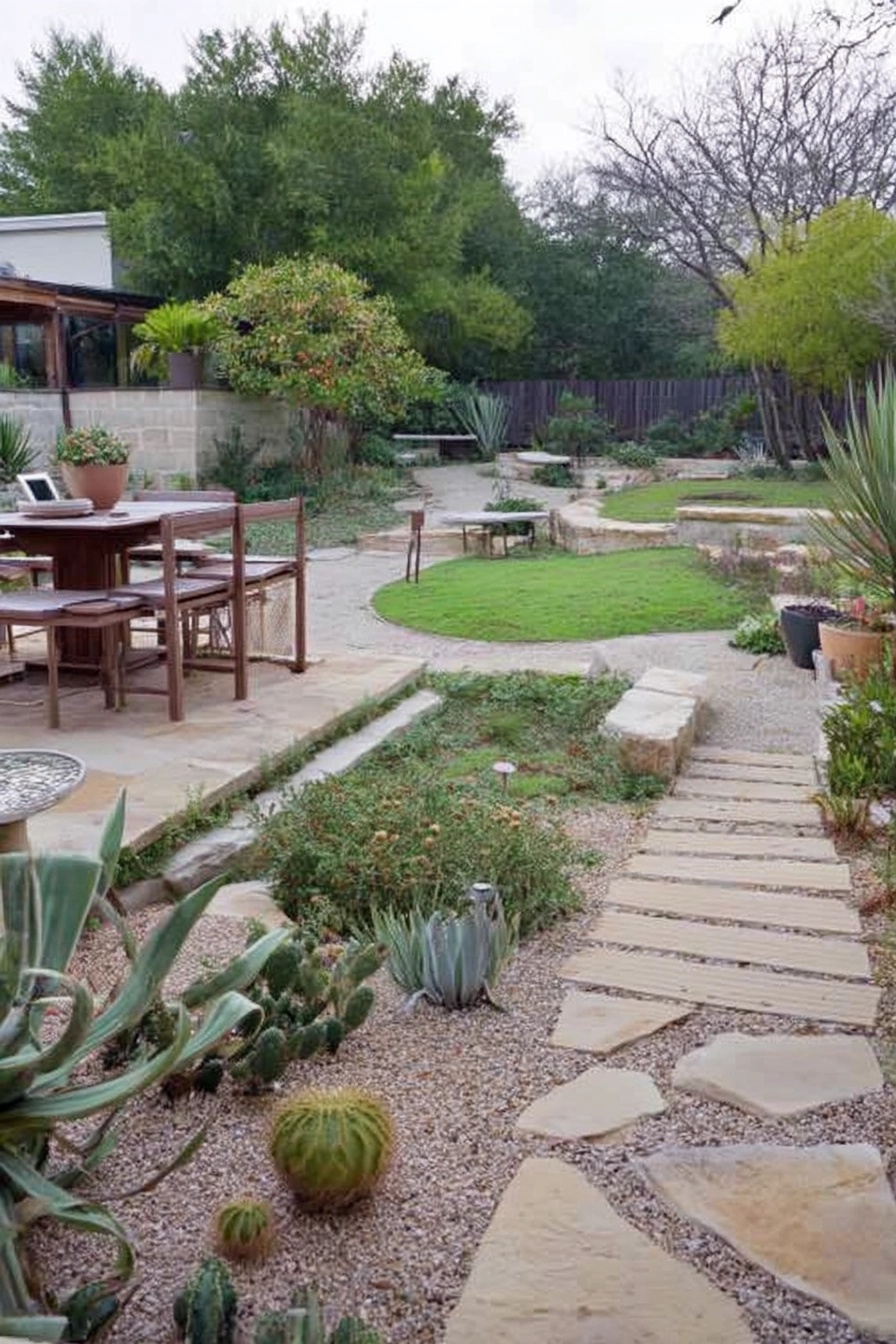
Check out how this larger front garden uses gravel paths to link different areas – a seating spot, a tiny lawn patch, planting beds with flagstone steppers. The gravel acts like the hallways of the garden.
Using the same gravel throughout creates cohesion, even though the different zones have unique characters. It’s a smart way to handle a bigger space without just defaulting to endless lawn.
This approach offers lots of variety. You can have sunny gravel beds with drought-tolerant plants, shadier spots under trees, a place to sit, maybe even a small water feature. The gravel pathways tie it all together visually.
Planning is key here. Think about how you want to move through the space and where you want your eye to be drawn. Sketch it out first – even a rough drawing helps!
11. Pet-Friendly Rocks: Boulders & Gravel Fun
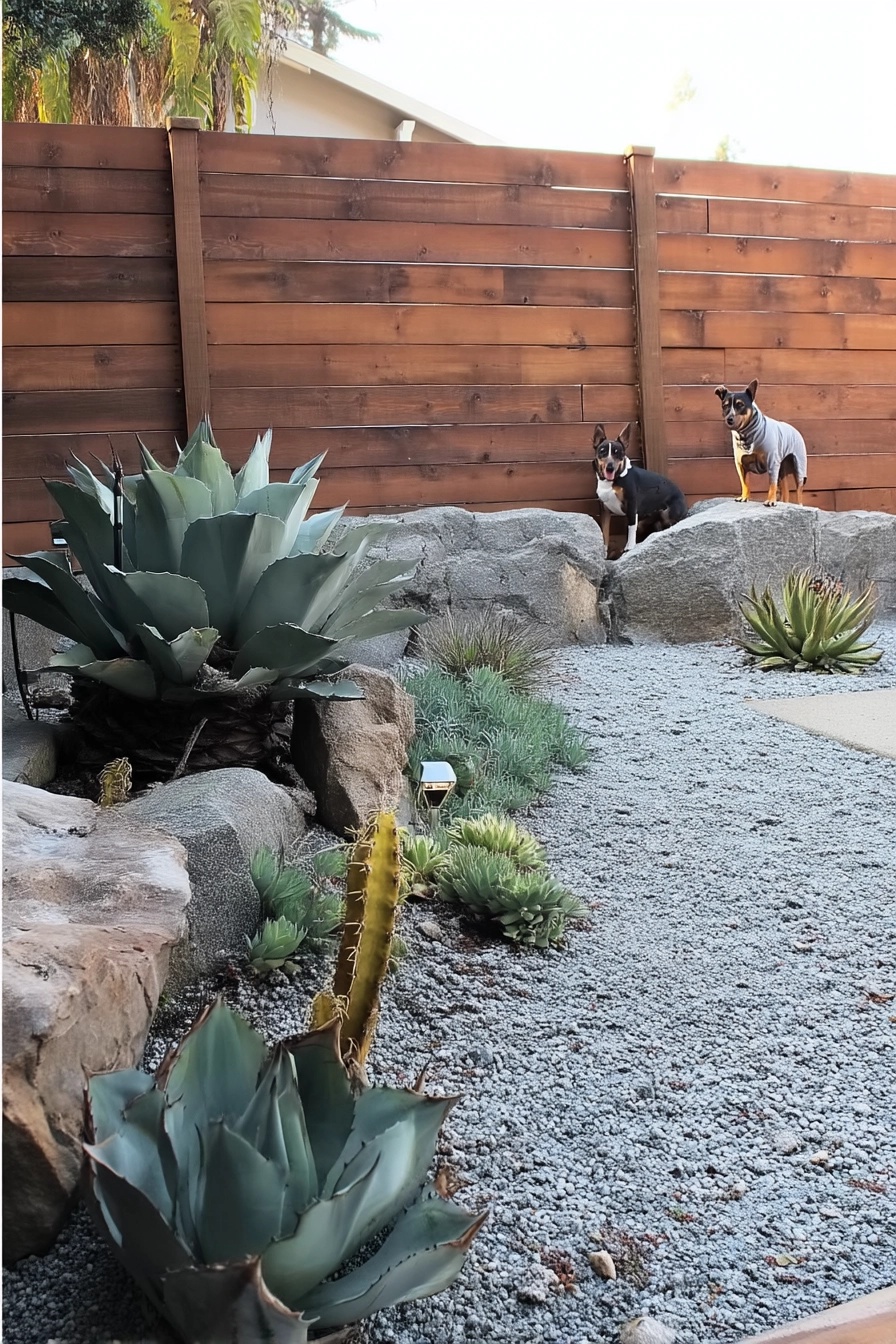
Okay, how cute are those pups? This shows how you can use gravel and even large boulders to create a dramatic, architectural look that pets can enjoy too (supervised, of course!).
The big boulders anchor the design and provide height, while the gravel fills the space around tough plants like agaves. It’s a very sculptural gravel garden idea.
If you have pets:
- Choose smoother gravel (like pea gravel or river stones) over sharp, angular crushed stone, which can be tough on paws.
- Be mindful that gravel, especially dark colours, gets HOT in direct sun. Provide shady spots or hose it down before letting pets lounge.
- Ensure plants are non-toxic if your pets are chewers!
My dog used to love scrambling on boulders in our yard. Just make sure they’re stable and there are no tricky gaps they could get stuck in!
12. Artistic Path: Patterned Stones in Gravel

Want something a bit different? Look for unique stepping stones like these! The natural patterns in the stone add an artistic touch to this gravel pathway.
Setting interesting steppers within a bed of simple river gravel lets the stones really stand out. It turns a functional path into a beautiful garden feature.
You can find stones like this at specialty landscape suppliers. Or, get creative! Think about using:
- Polished concrete rounds
- Sliced wood logs (treated for outdoor use)
- Reclaimed bricks or tiles (ensure they’re frost-proof)
Just make sure whatever you use is flat enough and stable for safe walking. Setting them slightly below the gravel level can look cool, but setting them slightly above is usually safer and keeps the gravel off the walking surface.
13. Urban Oasis: Deck, Gravel & Simplicity
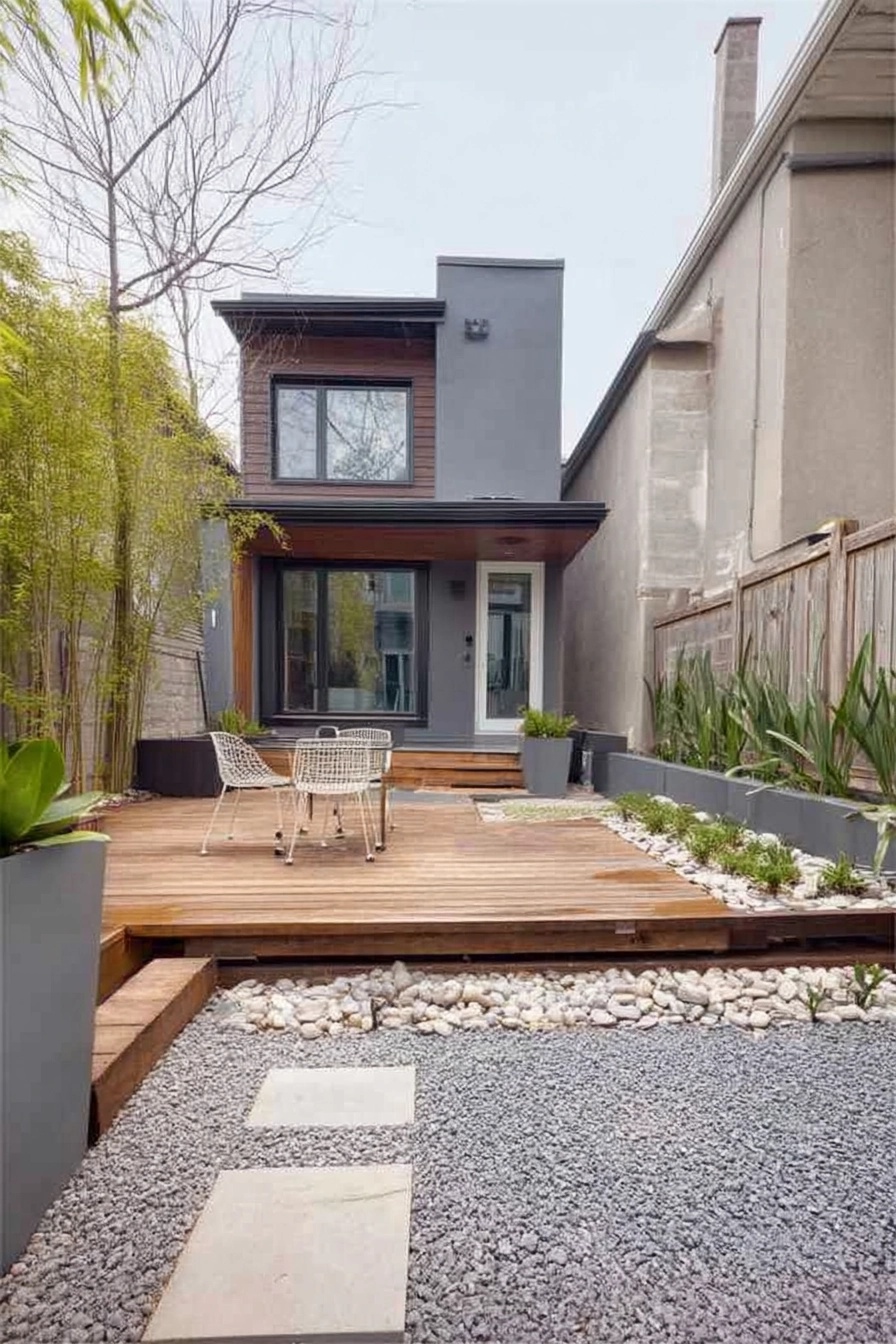
Even tiny front yards can pack a punch! This design cleverly combines a wooden deck for seating with a gravel area featuring simple pavers. It maximizes usable space in a narrow lot.
This is a fantastic low-maintenance solution for city living or townhouses. The grey gravel provides texture and drainage, while the deck adds warmth and a place to relax.
Keeping the planting simple – maybe some bamboo (clumping kind only, please!) or grasses in sleek planters – enhances the clean, modern feel. It’s all about making the most of limited square footage.
One thing I’ve learned with small spaces: less is often more. Trying to cram too many ideas or materials in can make it feel chaotic. Stick to a simple palette like this.
14. Warm Welcome: Terracotta Pavers & Path Lights
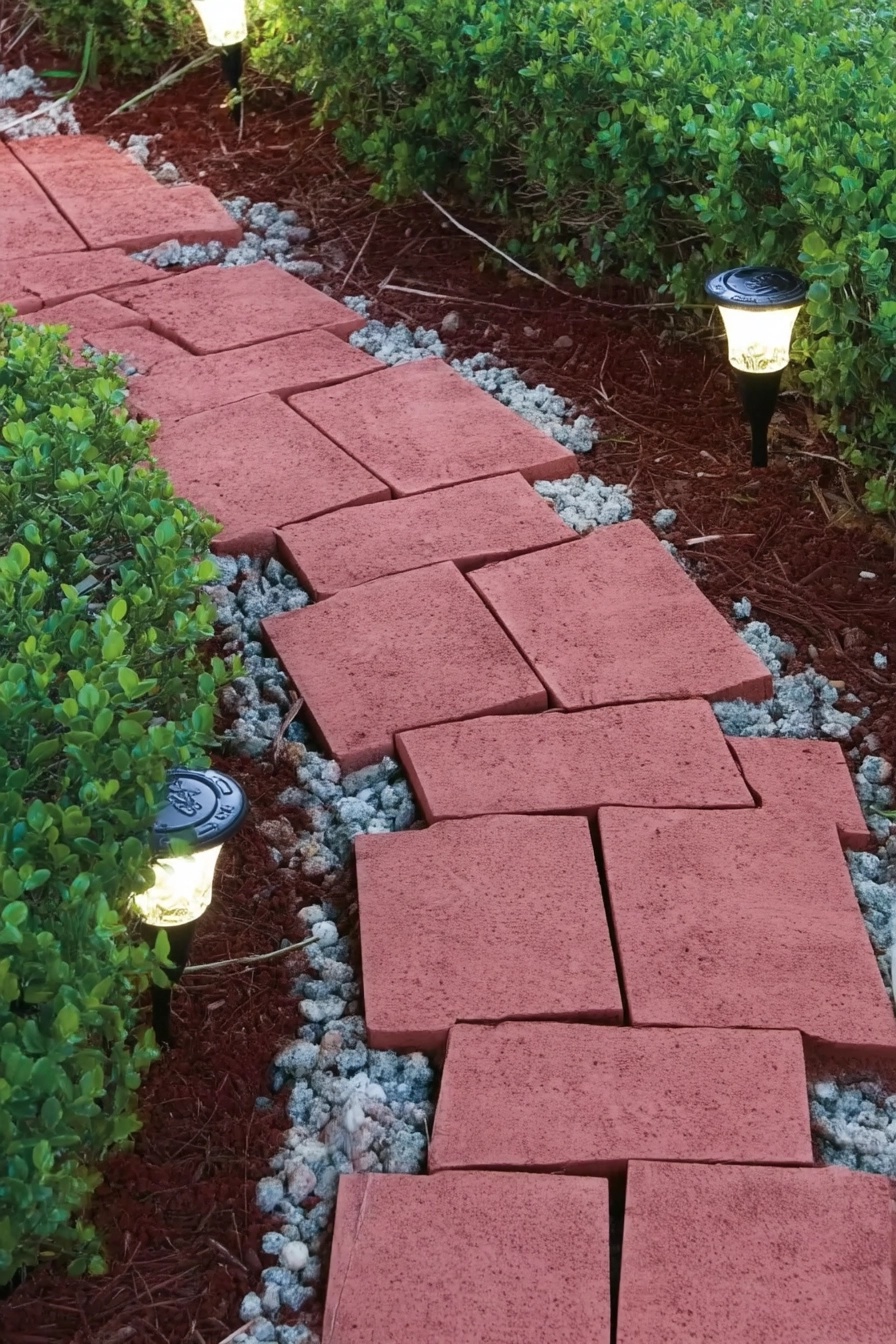
This path has a warmer, more traditional feel, thanks to those terracotta-colored pavers. Setting them in a fine gravel or even mulch creates a softer look than concrete and grey stone combinations.
And see those path lights? Don’t underestimate landscape lighting! It adds safety, highlights your beautiful path at night, and creates amazing ambiance. Solar lights are super easy to install – no wiring needed.
Tools you might need for a paver path like this:
- Shovel & Rake (for leveling the base)
- Tamper (to compact the base material – crucial!)
- Level (to get those pavers nice and even)
- Landscape Fabric (always!)
- Edging (to keep gravel contained)
Taking the time to prepare a solid, level base is the secret to a paver path that lasts and doesn’t wobble. Don’t skimp on this step!
15. Desert Texture Play: Boulders, Gravel & Cacti
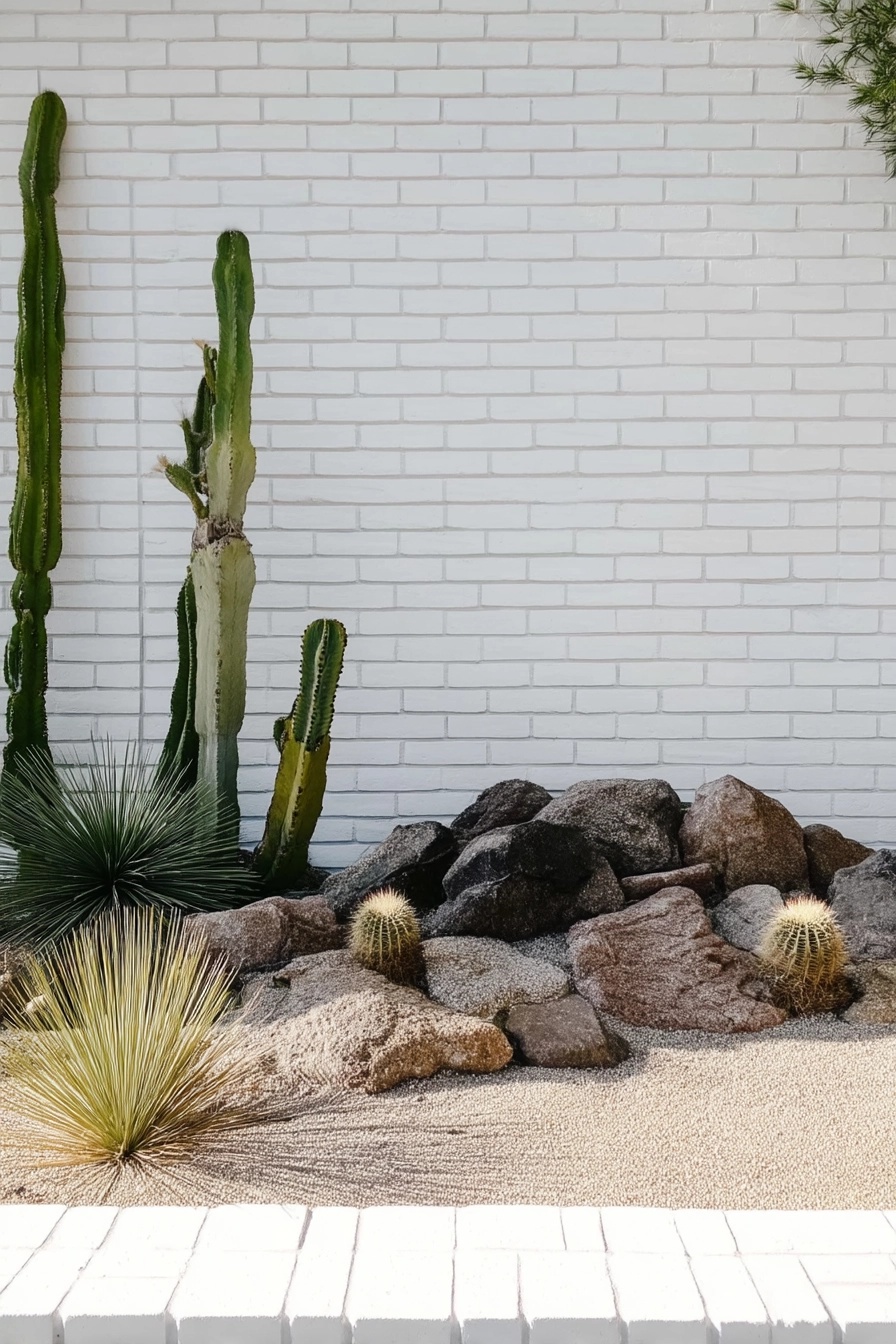
This is desert landscaping elevated to art! Look at the fantastic mix of textures: fine, light-colored gravel, chunky dark boulders, spiky cacti, and the smooth white wall as a backdrop.
Placing boulders strategically creates focal points and adds height variation. Grouping different types of cacti together adds interest. This design is all about contrast and form.
Using very fine gravel or even decomposed granite (“DG”) gives that clean desert floor look. It compacts nicely but still allows drainage. Perfect for showcasing sculptural plants.
Living in Arizona, I saw so many stunning examples of this style. It’s incredibly well-suited to hot, dry climates and looks effortlessly chic with mid-century modern or contemporary homes.
16. Mediterranean Charm: Flagstones & Lavender
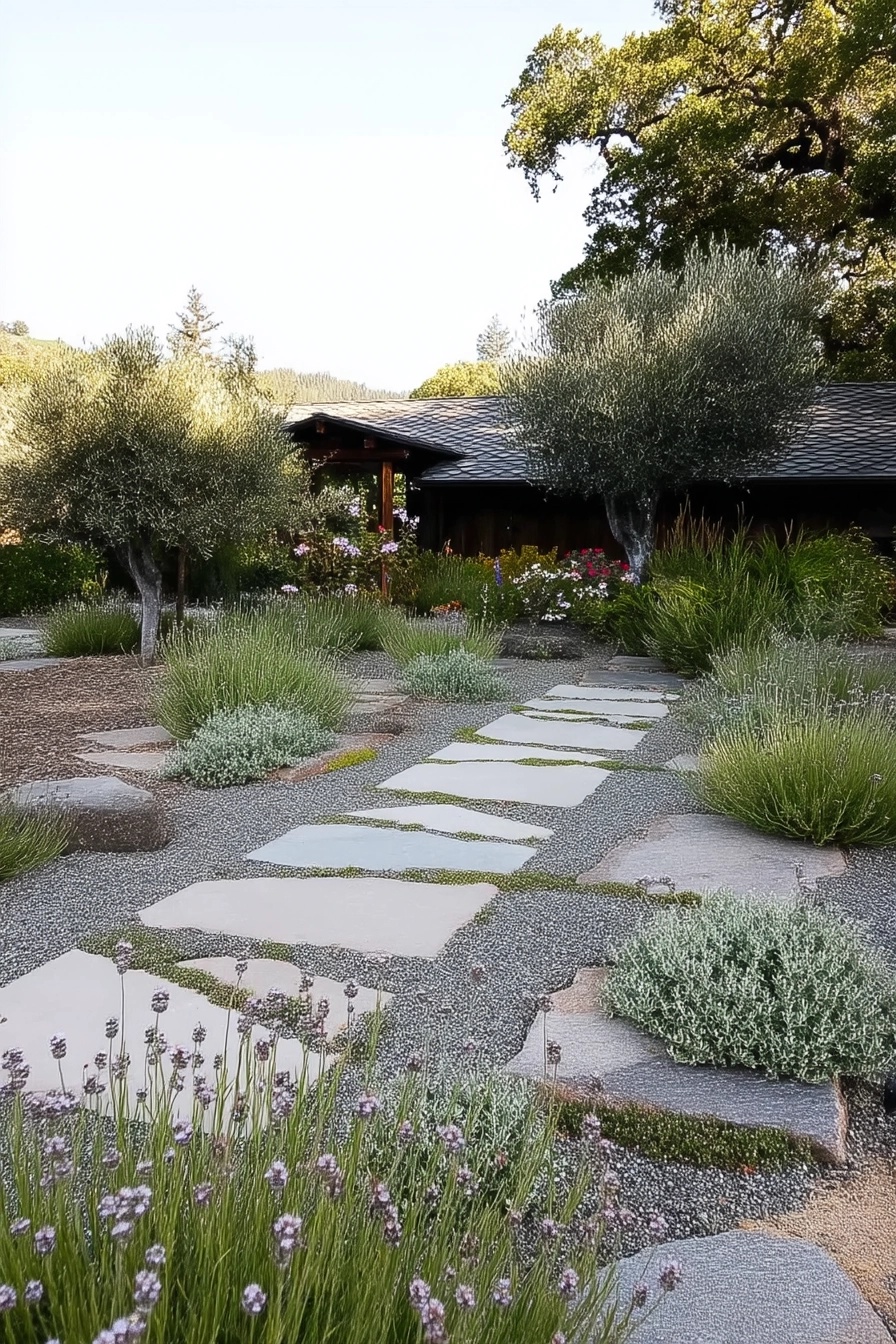
Doesn’t this just make you want to wander through with a glass of lemonade? The irregular flagstones nestled in dark gravel, flanked by soft mounds of lavender and silvery foliage – pure Mediterranean bliss!
This style is less about rigid lines and more about soft textures and fragrant plants. Olive trees, rosemary, santolina, and thyme would all feel right at home here.
The dark gravel helps the lighter flagstones pop and provides a nice contrast to the grey-green foliage. Letting low-growing plants like creeping thyme spill over the edges softens the path further.
One fail I had early on: planting things too close to the path edge. Remember they’ll grow! Give them space so they don’t completely swallow your walkway in a year.
17. Bold Geometry: Modern Pavers & Spheres
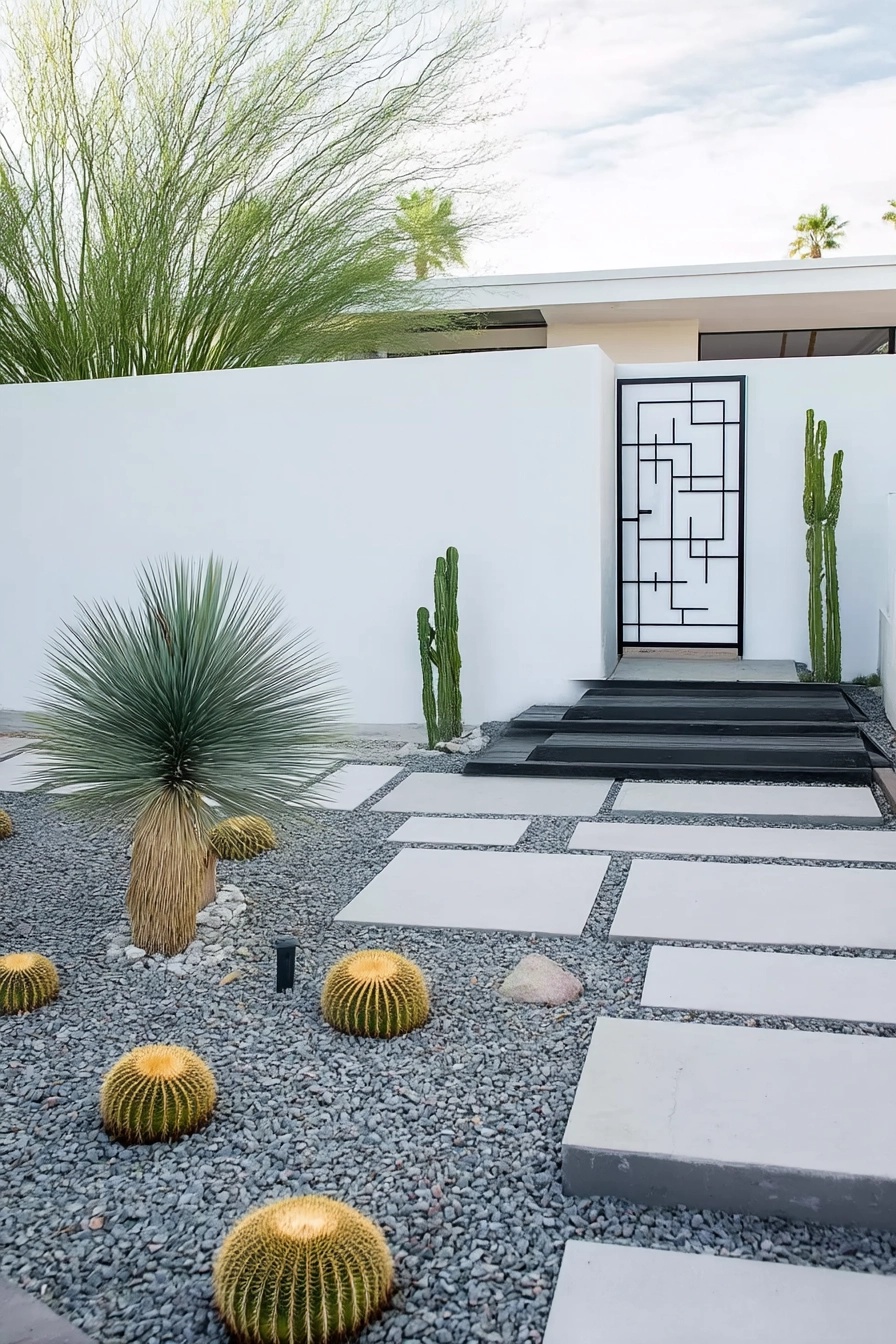
This gravel front garden idea is super bold and graphic. The oversized rectangular pavers laid out geometrically in dark grey gravel create a strong visual pathway.
Adding spherical barrel cacti repeats the geometric theme but with organic forms. It’s a really effective contrast. And that gate! It ties the whole modern aesthetic together.
This look demands precision. The spacing between pavers needs to be exact, and the gravel needs to be kept neat. It’s high-impact but might require more meticulous upkeep than looser styles.
Opinion Time: While I admire the artistry, sometimes these super-stark designs can feel a little unwelcoming. I might add one or two slightly softer plants nearby just to balance the hard lines, but maybe that’s just my old-school gardener sensibility talking!
18. Simple & Striking: Agave Meets River Stone

Sometimes, one spectacular plant is all you need! This large agave makes a huge statement set against simple, smooth grey river stones. The gravel provides a clean, neutral canvas.
This is minimalism done right. The focus is entirely on the plant’s dramatic form. The nearby wood decking adds warmth and texture contrast.
Using larger river stones like this works well around feature plants. They don’t get kicked around easily and provide good drainage. Just remember that weed barrier!
Agaves are fantastic low-water choices, perfect for a gravel front yard. Just be sure to plant them away from high-traffic paths – those spikes mean business! (Learned that the hard way brushing past one too quickly!)
19. Stepping Stones Revisited: Patterned Path Design
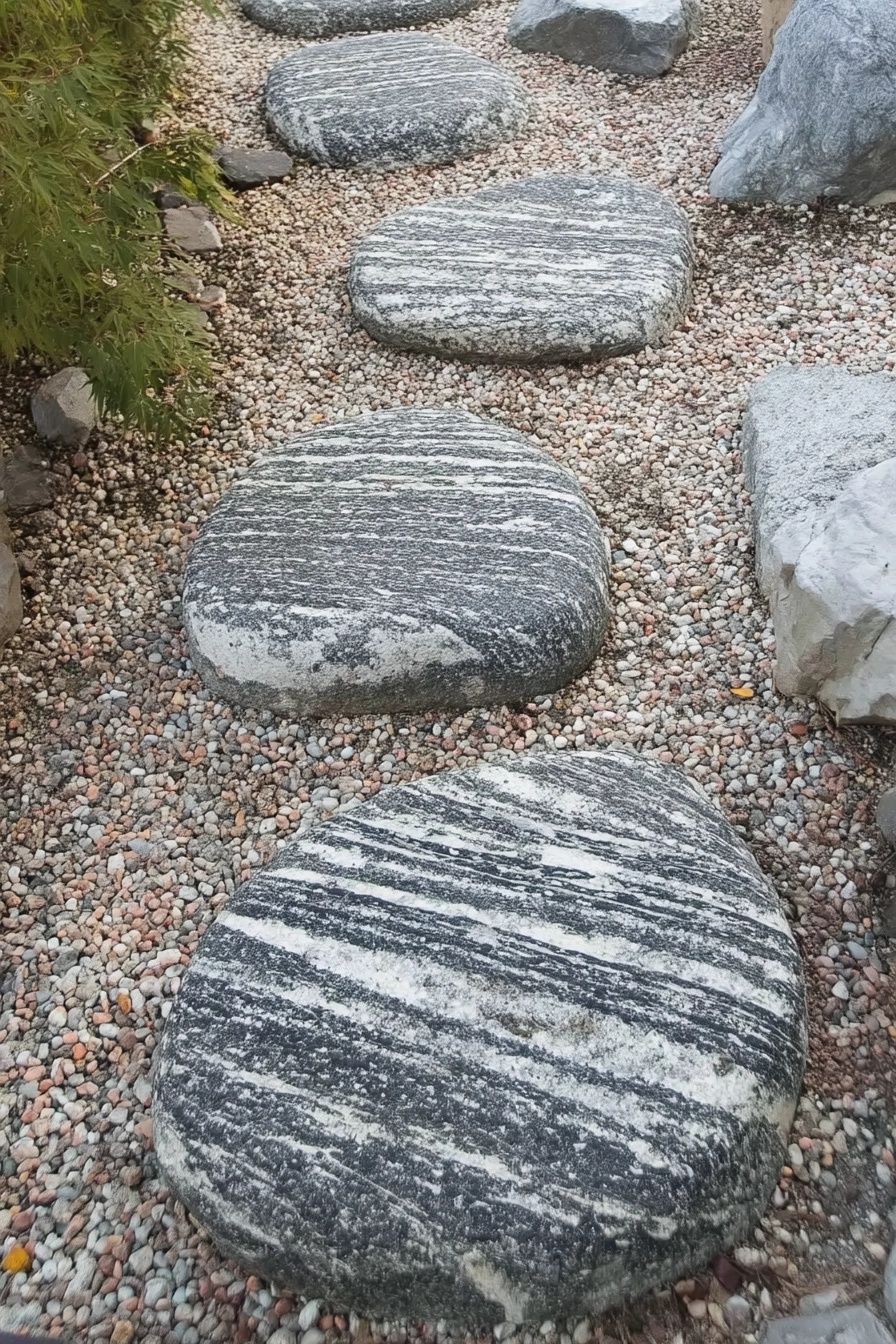
Here’s another take on using unique stepping stones! These have a really cool striped pattern, adding tons of visual interest to the gravel path.
Like the previous example (item #12), setting these special stones within a bed of simpler, mixed-color river gravel makes them the stars. It shows you don’t need complicated planting to create an eye-catching garden feature.
Finding stones exactly like this might require searching specialty stone yards. But the principle is the same: look for natural stones with interesting colors, textures, or patterns to elevate your gravel path from purely functional to fantastic.
Make sure your stepping stones are thick enough to be stable and set them firmly into the base layer so they don’t rock when you step on them. Safety first, style second!
20. Sharp Edges: Corten Steel Meets Gravel
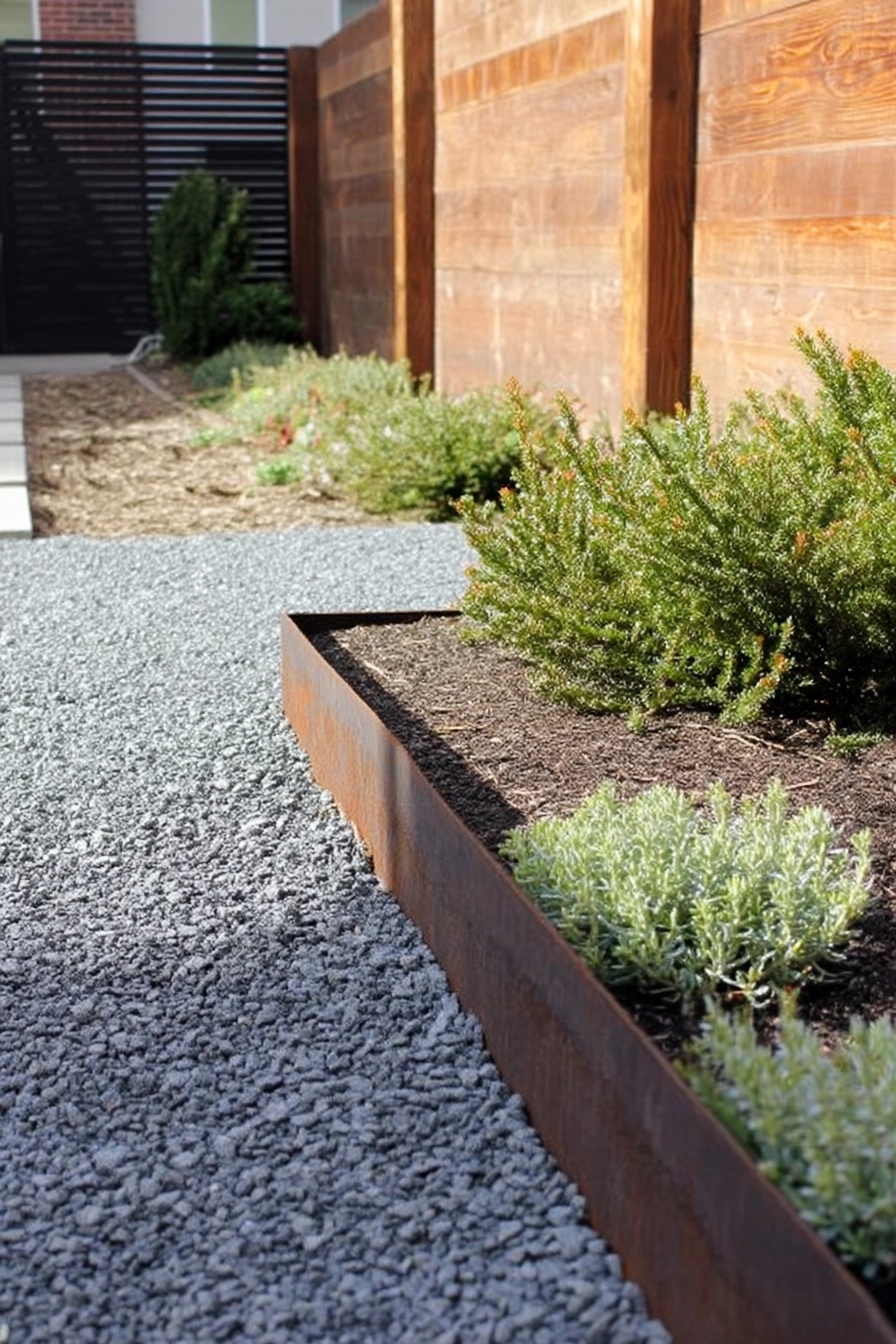
Want super crisp lines between your gravel areas and planting beds? Metal edging is the way to go, and Corten steel (the rusty-looking kind) is seriously popular right now.
Look how sharp that edge is! It creates a really clean separation between the fine grey gravel and the soil in the raised bed. This is a very modern front garden gravel border idea.
Pros: of Corten Steel Edging:
- Develops a stable, attractive rust patina that protects the steel underneath.
- Very durable and long-lasting.
- Creates incredibly clean lines.
Cons: to think about:
- Can be more expensive than other edging options (like plastic or basic metal).
- The rust can initially stain adjacent concrete or pavers (less of an issue next to gravel).
- Installation requires more effort than simple plastic edging.
I’ve used metal edging like this, and while it’s more work upfront, the clean look lasts for years. It’s great for defining shapes in a contemporary gravel garden design.
21. Desert Blend: Sand Meets Gravel Landscape

This final idea takes us back to the desert vibe, but with a twist. Notice how they’ve combined areas of fine sand with coarser gravel? It creates subtle shifts in texture and color.
This minimalist approach works perfectly with the mid-century modern architecture. The focus is on the clean lines, the sculptural plants (cacti and agaves again!), and the different ground textures.
Using sand can give a very authentic “desert floor” feel. However, sand is much lighter than gravel and can blow around or wash away more easily in wind and rain. It also tracks everywhere! Something to keep in mind if you have kids or pets constantly running in and out.
For me, living in Arizona, pure sand areas often meant more sweeping near the doorway! I generally prefer using decomposed granite or fine gravel for a similar look with a bit more stability. But visually, this sand and gravel combo is undeniably cool and serene.
FAQ
Q: What are the main benefits of using gravel in a front garden?
A: Gravel is brilliant for front gardens primarily because it’s very low-maintenance, suppresses weeds effectively (when paired with landscape fabric), and improves drainage. It also offers a clean, contemporary aesthetic and comes in various colours and sizes to suit any style.
Q: How can I incorporate borders using gravel in my front garden design?
A: Gravel makes fantastic borders! You can use it to edge pathways, define planting beds, or create a neat separation from a lawn or driveway. Simply create a defined edge (using metal, stone, or wood edging), lay down weed membrane, and fill with your chosen gravel for a crisp, textured look.
Q: Is gravel suitable for a front garden that also includes a driveway?
A: Yes, absolutely! Using gravel for both your garden areas and driveway can create a wonderfully cohesive look. Just ensure you use a chunkier, angular gravel (like crushed stone rather than smooth pea gravel) for the driveway area, laid over a proper sub-base, so it compacts well and provides a stable surface for vehicles.

